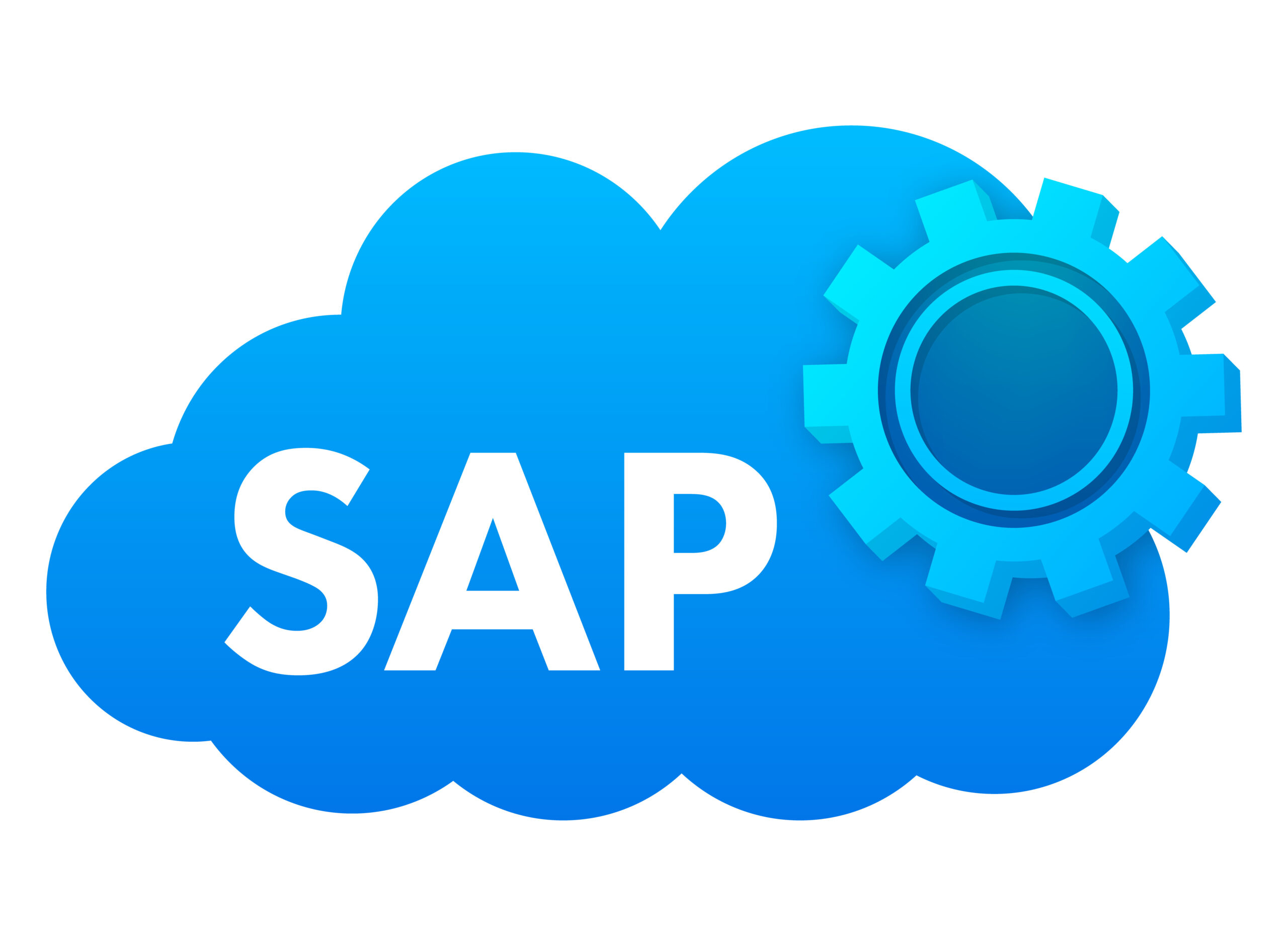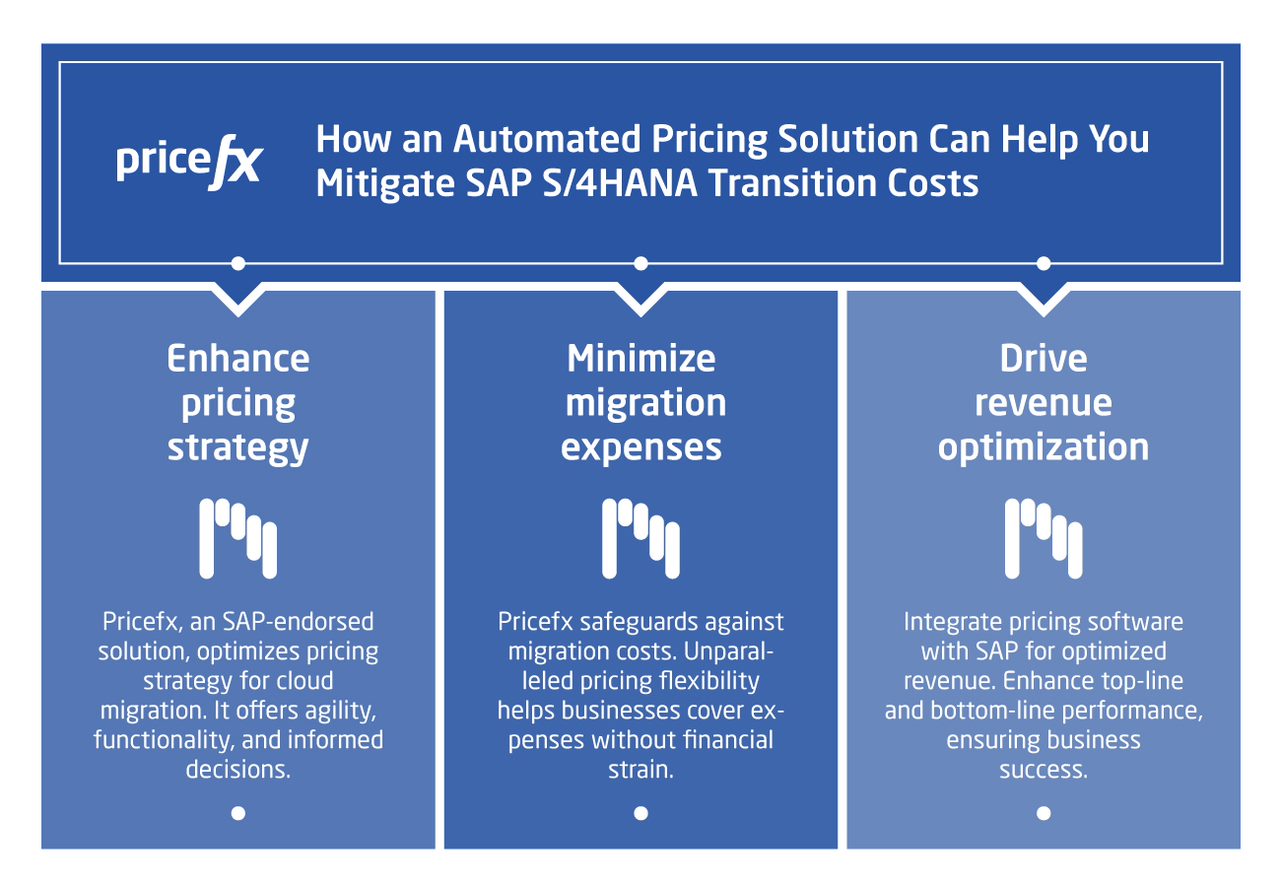SAP Cloud Transition Cost Mitigation: Automated Pricing
August 9th, 2023 (Updated 10/06/2023) | 7 min. read
December 2027 is the deadline SAP has set for customers to move to S/4HANA from its predecessor, Business Suite and its digital core, SAP ERP Central Component (ECC), which it plans to stop supporting in 2030. Until now, many ECC customers have remained cautious about migrating to the latest S/4HANA because of the migration costs involved and the relative lengthy and complex project duration, and those reasons will only worsen if they fail to act quickly. SAP legacy customers must undertake their SAP Cloud Transition soon, or they will be at a competitive disadvantage, impacting their digital transformation journey and with that, missing out on helping their organizations to make data-driven and profitable pricing decisions.
For over a decade, Pricefx has been assisting businesses in successfully transitioning from their legacy systems and maximizing the value of their native-cloud based automated pricing solutions. With the impending deadline for the SAP S/4HANA migration, we understand the challenges of cost and complexity. Our AI-powered pricing tools offer a way to mitigate transition expenses and ensure competitive advantage by enabling data-driven and profitable pricing decisions to offset the costs of migration process.
So, let’s jump straight into a discussion outlining the benefits of the migration, before we analyze the outlining the challenges of transitioning to SAP S/4HANA benefits of the migration, key considerations for transitioning from ECC to S/4HANA and finally, how pricing software can help mitigate the transition costs.
The Benefits of Migrating to SAP S/4HANA

Despite the challenges, migrating to SAP S/4HANA offers several benefits that can significantly improve business success. SAP S/4HANA redefines ERP (Enterprise Resource Planning) systems and is considered the most notable update since the introduction of SAP R/3 in 1992. Some of the key benefits include:
- Real-time data access – SAP S/4HANA enables businesses to access real-time data, providing valuable insights and facilitating better decision-making in a dynamic market environment.
- Cloud-based flexibility – Moving to the cloud allows businesses to scale their operations easily, adapt to changing business needs, and take advantage of new technologies and innovations.
- Enhanced efficiency and productivity – SAP S/4HANA offers streamlined processes, improved user experience, and automation capabilities, leading to increased efficiency and productivity.
- Easy integration with native-cloud pricing software systems – S/4HANA transitioned companies can seamlessly integrate their ERP system with cloud-based pricing software, unlocking additional capabilities and improving their bottom-line growth. With the integration of native-cloud pricing software, businesses can leverage advanced pricing algorithms, real-time market data, and automation features to optimize their pricing strategies. This enables them to stay competitive, respond quickly to market dynamics, and make data-driven pricing decisions that drive profitability. The combination of SAP S/4HANA and native-cloud pricing software offers a powerful solution for companies looking to enhance their pricing capabilities and achieve positive business outcomes.
Check out this great watch-on-demand webinar below to discover if your business is ready to transition to SAP S/4HANA. Click on the image to watch this webinar now:
Or to register to watch our entire free library of webinar content, by clicking here.
The Challenges of Transitioning to SAP S/4HANA
A considerable number of SAP users are still in the process of transitioning to SAP S/4HANA, with only a small portion having completed the update so far.
According to LeanIX’s SAP S/4HANA 2022 Survey, just 12% of respondents have finished the transformation, highlighting the perception of the migration as a business transformation rather than a mere technical upgrade by over half (54%) of the participants.
The survey also identified two key challenges faced by companies during the migration process:
- The difficulty in identifying interdependencies between ERP and non-ERP landscapes poses a significant challenge during the migration process. To define an accurate overview of the software landscape within 30 days was a challenge for more than 80% of respondents.
- Defining a target architecture for the migration has been an issue. Without a clear plan and architecture in place, businesses may face difficulties in successfully transitioning to SAP S/4HANA.
A lack of collaboration emerged as the most significant obstacle for two-thirds of the survey respondents, emphasizing the importance of effective teamwork between business, project, and IT teams to ensure a seamless transition.
Key Considerations and Transition Steps from ECC to SAP S/4HANA
For brevity’s sake (and your convenience), we have provided the transition steps required from ECC to SAP S/4HANA for you here below in an easy-to-understand checklist format.
For those interested in a deep dive into the following SAP Cloud transition steps, check out this article below where the transition steps are explained in greater detail.
- Assess current ECC system – Identify business requirements, goals, and expectations for migration to S/4HANA. This can help determine the best migration strategy, scope, timeline, and budget for the project.
- Choose migration strategy – Greenfield (new S/4HANA system), Brownfield (convert existing ECC system), or Hybrid (selective migration).
- Prepare data and applications: Clean up data, ensure quality and custom code compatibility, and resolve conflicts that may arise during the migration process.
- Utilize the right tools and best practices – Maintenance Planner, Software Update Manager (SUM), Readiness Check, Application Conversion Assistant, Custom Code Migration Guide.
- Test and validate migrated system – Functional testing, integration testing, performance testing, security testing, and user acceptance testing to ensure that the migrated system meets the business requirements and expectations, and that there are no errors or issues that may affect the system functionality or performance.
- Go live with S/4HANA – Monitor and optimize following integration: Smooth cutover, training, support, troubleshooting, system enhancement.
How an Automated Pricing Solution Can Help You Mitigate SAP S/4HANA Transition Costs
As mentioned previously, the cost implications of the transition pose a significant concern for businesses. However, there is a solution to mitigate this challenge: the implementation of an automated pricing solution.
 By harnessing the power of pricingsoftware, businesses can achieve the following benefits:
By harnessing the power of pricingsoftware, businesses can achieve the following benefits:
- Enhance pricing strategy: By utilizing an SAP-endorsed pricing solution such as Pricefx, businesses can optimize their pricing strategy in preparation for the migration to the cloud. This solution provides valuable pricing agility, functionality, utility, and capability, empowering businesses to make well-informed pricing decisions.
- Minimize migration expenses: The pricing solution acts as a safeguard against the costs associated with the migration process. It offers unparalleled pricing flexibility, ensuring that businesses have a viable means to cover the expenses of the migration without incurring significant financial strain.
- Drive revenue optimization: Integrating the pricing software with SAP enables businesses to achieve pricing and revenue optimization throughout the lead-to-cash process. This comprehensive approach enhances both top-line and bottom-line performance, contributing to the overall success of the business.
The transition from SAP on-premise solutions to cloud-based solutions is necessary for businesses to stay competitive and thrive in today’s digital landscape. While there are challenges associated with the migration process, the benefits of migrating to SAP S/4HANA are substantial. Effective collaboration between business, project, and IT teams is crucial for a successful transition. Additionally, leveraging a quality automated pricing solution like Pricefx can help mitigate transition costs and provide pricing flexibility during the migration.
And the greatest advantage of Pricefx as a pricing platform for SAP users is the closeness of our relationship with SAP, which you can learn more about by clicking on the article link below:
On the other hand, if your company already has everything organized to begin your pricing software journey, talk to one of our pricing experts today to get started.
Happy Pricing!


